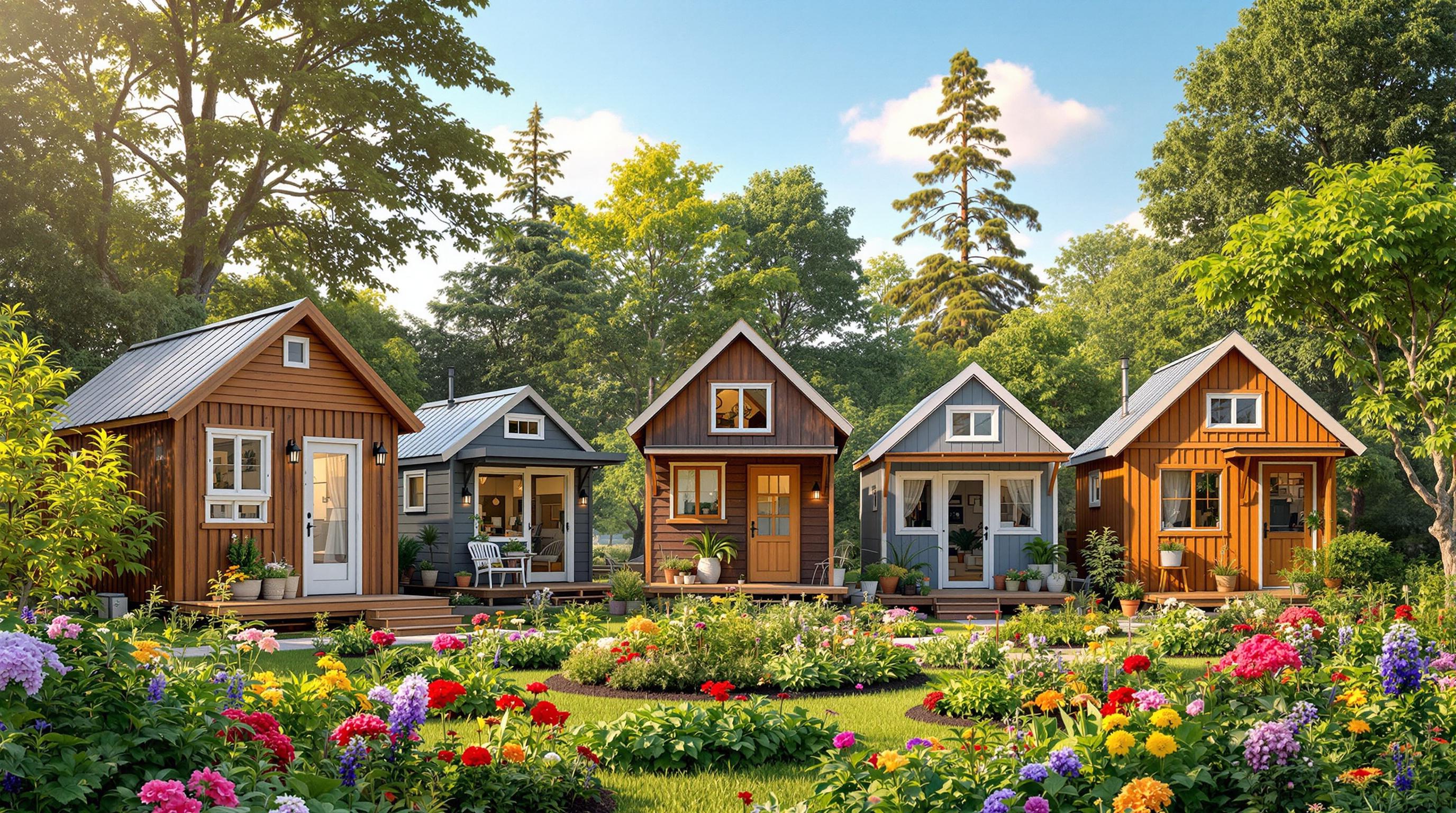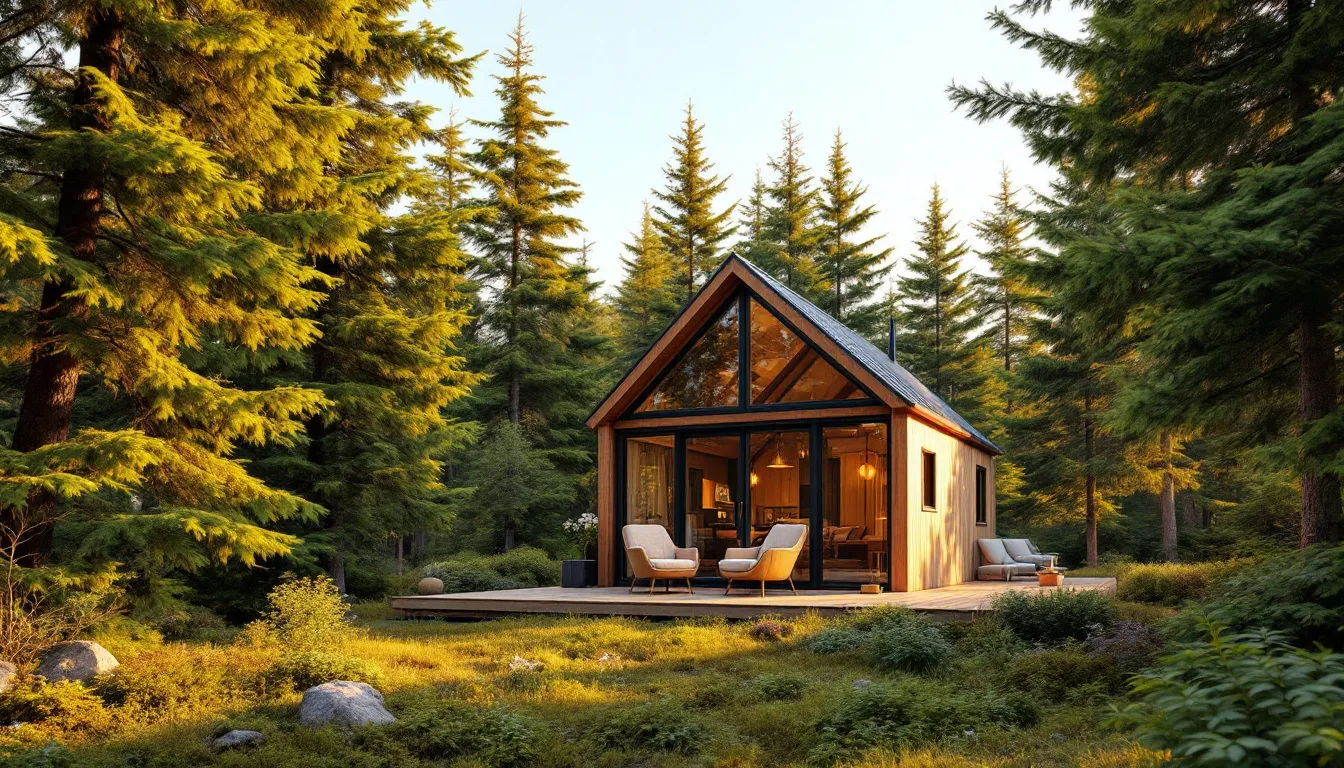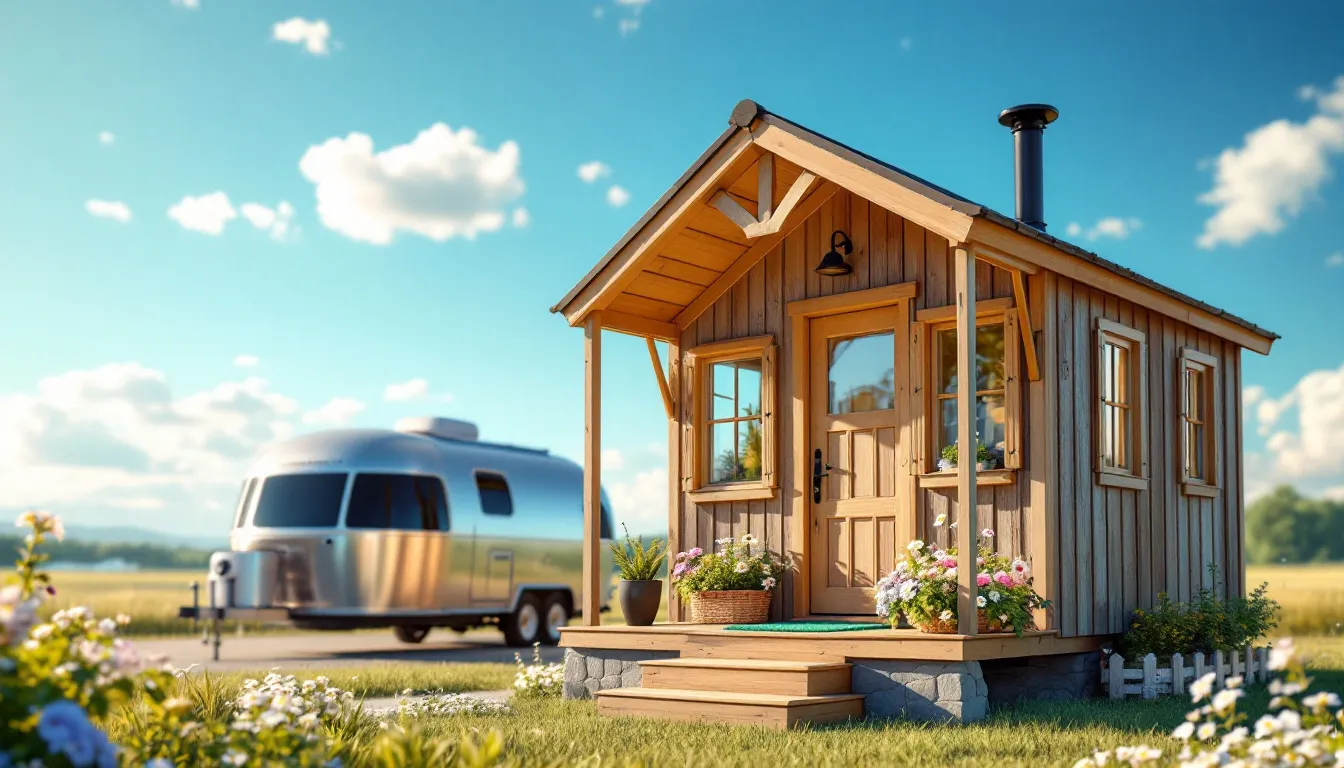A tiny house is a home typically sized at 400 square feet or less, offering a minimalist lifestyle with lower costs, eco-friendly features, and mobility options. Here's what you need to know:
- Definition: Compact homes, often on wheels, ranging from 60 to 400 sq. ft.
- Key Features: Smart layouts, space-saving furniture, and sustainable designs like solar panels and rainwater systems.
- Types:
- On Wheels: Mobile, up to 8.5 ft wide, 40 ft long, and 13.5 ft tall.
- On Foundations: Permanent, slightly larger, with more design flexibility.
- Unconventional: Includes container homes, houseboats, and converted buses.
- Costs: Starting as low as $20,000, with reduced utility and maintenance expenses.
- Challenges: Zoning laws, limited storage, and adapting to smaller spaces.
Tiny houses promote simplicity, affordability, and a smaller environmental footprint, making them an appealing option for those seeking a minimalist lifestyle.
Features and Advantages of Tiny Houses
Smart Use of Space
Tiny houses are all about making the most of limited space. In a typical 200-square-foot tiny house, you'll find clever design elements like Murphy beds, storage-packed staircases, convertible tables, lofts, and compact appliances. These features are crafted to make small spaces not just livable, but functional, using built-in storage and vertical layouts to their full potential.
Eco-Friendly Living
Tiny houses are designed with sustainability in mind. Many include solar panels, rainwater collection systems, composting toilets, LED lighting, and natural insulation. These features help cut down energy use and promote a greener way of living.
Lower Costs
With prices ranging from $20,000 to $50,000 [1], tiny houses offer a more affordable alternative to traditional homes. Monthly expenses are also significantly reduced:
| Expense Category | Monthly Savings |
|---|---|
| Utilities | 50–75% less |
| Property Tax | Minimal or none |
| Maintenance | 60–80% lower |
| Insurance | Much cheaper |
Flexibility and Mobility
Tiny houses on wheels bring freedom and flexibility. They allow owners to:
- Move for job opportunities
- Explore new communities
- Travel while keeping a home base
- Avoid standard property taxes
- Adjust to life’s changing needs
With their smart design, lower costs, eco-friendly features, and mobility, tiny houses are a compelling choice for anyone looking to embrace a simpler lifestyle. However, it's worth weighing the challenges that come with this way of living.
Related video from YouTube
Different Types of Tiny Houses
Tiny houses embrace the idea of living with less while offering diverse options to fit various needs and lifestyles. They generally fall into three main categories: mobile tiny houses, foundation-based homes, and unconventional designs like container homes or houseboats. Each type has its own perks and challenges.
Tiny Houses on Wheels
These homes are built for mobility, typically ranging from 60 to 400 square feet. To travel safely on roads, they must meet specific size limits: 8.5 feet wide, 40 feet long, and 13.5 feet tall [3]. Tiny houses on wheels give homeowners the freedom to move whenever they want - whether it’s chasing better weather, exploring new places, or adapting to life changes - without needing a fixed foundation.
Tiny Houses on Foundations
For those looking for a more permanent setup, foundation-based tiny homes are a solid choice. They aren’t restricted by road size regulations, so they can be slightly larger and offer more design options [2]. Some key benefits include:
- Stability and easy access to utilities like water, electricity, and sewage.
- The ability to use traditional building materials for a more conventional look.
- Greater durability and a sense of permanence.
Unconventional Tiny Homes
These options push the boundaries of traditional housing with creative designs and unique features:
| Type | Key Features |
|---|---|
| Container Homes | Made from shipping containers, these are durable, budget-friendly, and customizable. |
| Houseboats | Perfect for waterfront living, offering a one-of-a-kind lifestyle. |
| Converted Buses | A mobile option that’s often more affordable than custom-built tiny homes. |
When deciding which type of tiny house suits you best, think about factors like local zoning rules, your lifestyle needs, and long-term plans [1]. Each option comes with its own set of challenges, from legal restrictions to adapting to a smaller living space.
sbb-itb-2ef3f3a
Challenges of Tiny House Living
Living in a tiny house comes with its own hurdles and requires thoughtful planning to make it work.
Understanding Zoning and Legal Rules
Navigating zoning laws and building codes is often one of the biggest challenges for tiny house owners. The 2023 International Residential Code (IRC) defines a tiny house as one that’s 400 square feet or smaller, excluding lofts [3]. However, local laws can add more layers of complexity.
Here’s what you need to check:
- Building codes and minimum square footage requirements
- Parking and land use restrictions
- Rules for utility connections
- Permits for tiny houses on wheels (THOWs)
Understanding these rules ahead of time can save you from costly setbacks.
Living in Small Spaces
Small spaces require smart solutions to make them functional and comfortable.
| Space Challenge | Solution Strategy |
|---|---|
| Limited Storage | Use vertical space and multi-use furniture |
| Lack of Privacy | Install dividers or curtains |
| Small Kitchen | Choose compact, foldable appliances |
| Tiny Bathroom | Go for corner sinks and composting toilets |
Planning your layout with these strategies in mind can make a big difference.
Shifting to a Simpler Lifestyle
Tiny house living is all about embracing minimalism and simplifying your lifestyle.
- Declutter First: Go through your belongings and separate them into essentials, seasonal items, and things to discard.
- Build New Habits: Adopt a "one in, one out" rule for possessions and focus on experiences rather than accumulating more stuff [1].
- Create Balance: Find ways to keep your favorite hobbies and activities alive by using multi-purpose furniture or setting up specific zones for them.
Weighing the Pros and Cons
Tiny houses come with both perks and challenges, so it’s important to weigh them carefully.
| Benefits | Challenges |
|---|---|
| Lower living costs | Complex zoning and legal requirements |
| Reduced energy usage | Limited storage space |
| Mobility for tiny houses on wheels | Adjusting to a smaller lifestyle |
| Lower utility bills | Resale difficulties |
| Weather and guest accommodation issues |
Taking the time to assess these factors will help you prepare for the realities of tiny house living, whether you plan to build, buy, or join a tiny house community.
Steps to Start Tiny House Living
Starting your tiny house journey comes with challenges like zoning laws, limited space, and lifestyle changes. However, with the right approach, it can be an exciting and rewarding experience.
Buying or Building Your Tiny House
Tiny houses often cost less than traditional homes, but prices can vary depending on size, materials, and how much customization you want. Think about what fits your goals and budget best.
| Option | Cost Range | Best For |
|---|---|---|
| Pre-built | $30,000-$60,000 | Faster move-in, minimal effort |
| DIY Kit | $10,000-$25,000 | Budget-friendly, hands-on projects |
| Custom Build | $45,000-$100,000 | Tailored designs and preferences |
Look for certification from the National Organization of Alternative Housing (NOAH) to ensure your tiny house meets safety and quality standards [2]. Also, make sure your design fits legal size and transport guidelines.
Here are a few key things to consider when planning your tiny house:
- The overall size of the home
- Whether it needs to be mobile or stationary
- Interior layout and functionality
- Local building codes and zoning laws
- How utilities like water and electricity will be connected
Finding Communities and Resources
Joining tiny house communities can provide valuable advice and support. These groups often share tips, resources, and guidance on navigating local regulations. You can connect with them through:
- Online platforms like Tiny House Swoon
- Local meetups for tiny house enthusiasts
- Social media groups
- Events like tiny house festivals
There are also plenty of resources to help you along the way:
| Resource Type | Purpose | Examples |
|---|---|---|
| Online Directories | Find builders and communities | Tiny House Search, Tiny House Swoon |
| Technical Guides | Understand building codes | IRC Guidelines (2023) |
| Planning Tools | Create layouts and designs | 3D modeling software, floor planners |
For a comprehensive directory of builders, zoning rules, and community opportunities, check out TinyHouseSearch.com [4]. It’s a great starting point to find everything you need to kick off your tiny house adventure.
Conclusion
Key Takeaways
Living in a tiny house is more than just a housing choice - it’s a shift in lifestyle. According to the International Residential Code (IRC), these homes are defined as being 400 square feet or less, not counting loft spaces [3]. From clever space-saving solutions to eco-conscious designs, tiny houses bring a variety of advantages that we’ve covered in this guide.
These homes offer lower costs, less environmental impact, easier upkeep, and a simpler way of living. Whether it’s a mobile tiny home on wheels averaging 350 square feet or a more permanent structure, tiny houses cater to those looking for a minimalist lifestyle with purpose [2].
Final Thoughts
Tiny house living goes beyond reducing square footage - it’s about making deliberate choices and prioritizing what truly matters. For those willing to embrace this lifestyle, it can lead to financial independence and a smaller environmental footprint. While challenges like zoning restrictions and limited space can arise, thoughtful planning can make this way of living both achievable and rewarding.
Tiny houses aren’t for everyone, but for those ready to simplify, they offer a cost-effective and intentional way of life. With more resources and supportive communities emerging, 2024 presents a great opportunity to explore this movement. Success lies in careful preparation and a commitment to living simply.
If you’re ready to take the leap, consider connecting with established tiny house communities through platforms like Tiny House Swoon and TinyHouseSearch.com [4]. This growing trend is in line with global shifts toward minimalism and eco-friendly living, providing a practical option for those aiming to live with purpose and reduce their impact.



